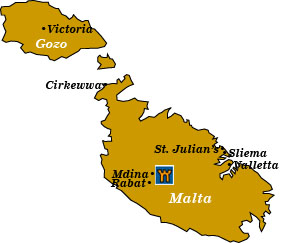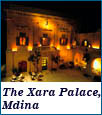 Castle Hotels of Malta
Castle Hotels of Malta 

Haven’t decided on a hotel yet? You can look at other available hotels in Malta with Booking.com.
The first impression that strikes the visitor to Malta is the sheer depth of its history. Neolithic temples, massive medieval walls, fortresses, baroque churches, and aristocratic town palaces are just the visible reminders of Malta’s fascinating past. Stories of the noble Knights of St. John defending the island during a Turkish siege and the courage of its populace during five months of continuous German bombing during WWII have created legends of heroism.
Today’s Malta offers not just a rich history, but splendid coastal scenery, water activities, quiet pursuits, good food and drink, and a hospitable welcome by the gracious and friendly Maltese.
Some great reasons to visit
![]() Valletta Surrounded by massive fortifications, Malta’s capital city was built in the 16th and 17th centuries by the Knights of the Order of St. John. Aristocratic, charming, and with some of the most fascinating architecture in the Mediterranean, it’s easy to spend days wandering through its narrow streets (laid out on a grid system to take advantage of the sea breezes). Worth a visit:
Valletta Surrounded by massive fortifications, Malta’s capital city was built in the 16th and 17th centuries by the Knights of the Order of St. John. Aristocratic, charming, and with some of the most fascinating architecture in the Mediterranean, it’s easy to spend days wandering through its narrow streets (laid out on a grid system to take advantage of the sea breezes). Worth a visit:
St. John’s Co-Cathedral Dedicated to St. John the Baptist in the 16th century, the cathedral somewhat resembles an austere fortress, but that’s just the exterior. The interior is sumptuously decorated in Maltese baroque style. Filled with the tombs of the Grand Masters and extraordinary artwork, the masterwork here is Carvaggio’s The Beheading of St. John the Baptist.
The Grand Master’s Palace Now the home of Malta’s parliament and official residence of its president, the palace was the former residence of the Grand Masters of the Knights of St. John. Some 5,000 pieces of armor once belonging to the knights is now housed in the Armoury. Trompe l’oeil paintings, Gobelin tapestries, and fine art adorns the state rooms.
National Museum of Archaeology This is the place to come to see the prehistoric artifacts found in Malta’s Neolithic and Bronze Age sites.
![]() Prehistoric temples The megalithic temples found on Malta date back to 3600-2500 BC, making them the oldest freestanding structures in the world—1000 years older than the pyramids of Egypt. The Hal-Saflieni Hypogeum, now a UNESCO World Heritage Site, is an underground necropolis (advanced bookings required); the Tarxien Temples feature immense stone blocks and fascinating carvings; Hagar Qim, composed of massive standing stones surrounded by a curtain wall, is where several of the finest figurines in the National Museum of Archaeology were found, and Mnajdra, romantically situated near the sea, may have served a calendar function, as during the winter and summer solstice, the first rays of the rising sun fall on an inner chamber.
Prehistoric temples The megalithic temples found on Malta date back to 3600-2500 BC, making them the oldest freestanding structures in the world—1000 years older than the pyramids of Egypt. The Hal-Saflieni Hypogeum, now a UNESCO World Heritage Site, is an underground necropolis (advanced bookings required); the Tarxien Temples feature immense stone blocks and fascinating carvings; Hagar Qim, composed of massive standing stones surrounded by a curtain wall, is where several of the finest figurines in the National Museum of Archaeology were found, and Mnajdra, romantically situated near the sea, may have served a calendar function, as during the winter and summer solstice, the first rays of the rising sun fall on an inner chamber.
![]() Mdina This charming walled city has origins in the Bronze Age. Phoenicians, Arabs, Normans, French, and Spanish left their influence by the narrow, twisting streets, beautiful town palaces, monasteries, and churches. Cafés with delightful views over the countryside make for relaxing ways to pass the afternoon.
Mdina This charming walled city has origins in the Bronze Age. Phoenicians, Arabs, Normans, French, and Spanish left their influence by the narrow, twisting streets, beautiful town palaces, monasteries, and churches. Cafés with delightful views over the countryside make for relaxing ways to pass the afternoon.
![]() Gozo Myth says that Gozo is the site of Calypso’s Cave where Odysseus was washed ashore. In our times, people come to this island north of Malta for the hiking, fishing, diving (some of the best in Europe), and the slow pace of life. Its main town Victoria is certainly worth a visit, especially to view the 17th-century Citadel, a massive fortification above the town now housing a series of museums. On the island, too, are the Ggantija Prehistoric Temples, the oldest free-standing stone building in the world—dating back to 3600 BC—and also the best preserved of all Malta’s Neolithic ruins.
Gozo Myth says that Gozo is the site of Calypso’s Cave where Odysseus was washed ashore. In our times, people come to this island north of Malta for the hiking, fishing, diving (some of the best in Europe), and the slow pace of life. Its main town Victoria is certainly worth a visit, especially to view the 17th-century Citadel, a massive fortification above the town now housing a series of museums. On the island, too, are the Ggantija Prehistoric Temples, the oldest free-standing stone building in the world—dating back to 3600 BC—and also the best preserved of all Malta’s Neolithic ruins.

